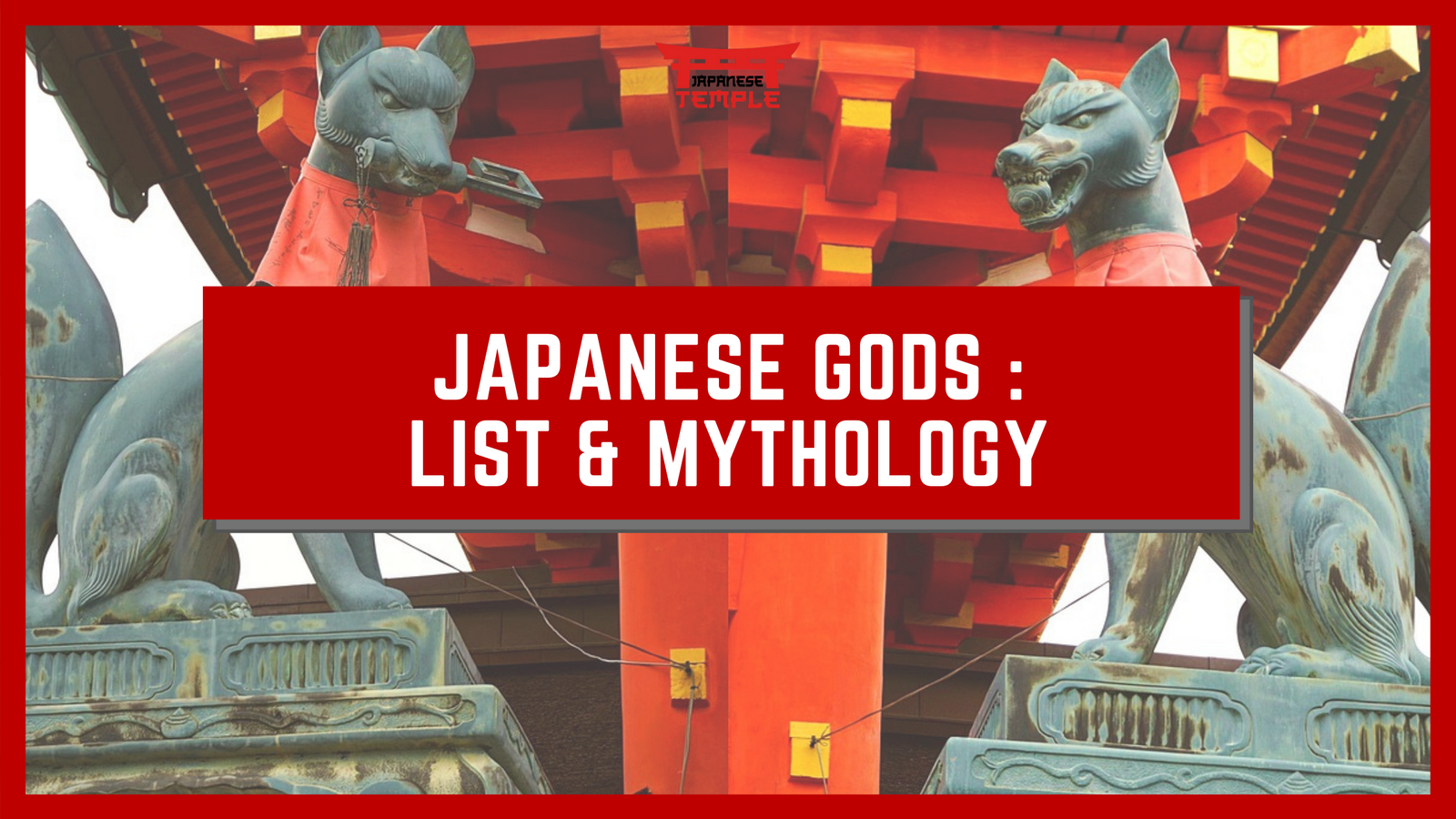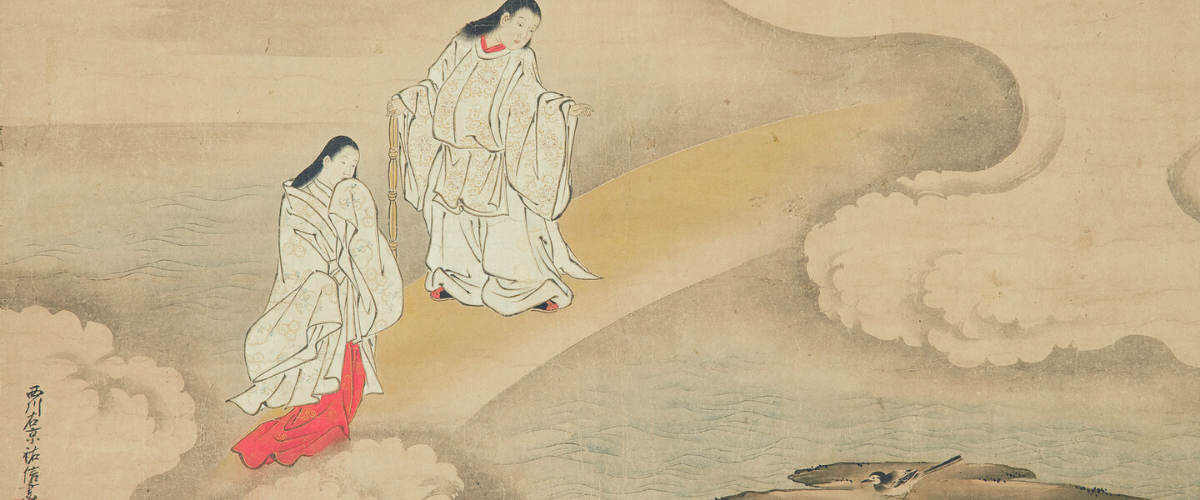Your Cart is Empty
⌛ TODAY FREE WORLDWIDE SHIPPING

In Shintoism, Kotoamatsukami (別天津神) which means "distinctly celestial Kami" is the general name given to the first gods of Japan. The Japanese gods appeared at the creation of the universe. They were all born in Takamagahara, the kingdom of the heavens and the residence of the gods.
In Japanese mythology, the three deities who appeared first were: Ame-no-Minakanushi (天之御中主神), Takamimusubi (高御産巣日神) and Kamimusubi (神産巣日神). A little later, two more deities joined the residence of the gods: Umashiashikabihikoji (宇摩志阿斯訶備比古遅神) and Amenotokotachi (天之常立神). So these 5 Gods belong to the first generation of gods.
The next generation of gods is called "Kamiyonanayo", this one included Izanagi-no-Mikoto and Izanami-no-Mikoto, considered as the father and mother of all other deities in Japanese mythology. This generation is the most popular and is, of course, the subject of this article.

Today, Japanese Temple makes you discover about 10 Japanese Gods with stories all the more incredible than the others and which directly influenced some of your favorite manga.
A little clarification, the term "Kami" in Japanese translates as "God" but also as "spirit" which explains why there is not always one single deity per element. In Shintoism, all objects on earth have a spirit, and therefore their own Kami.
To begin, here is a small list of the 14 most popular Japanese Kami of the Japanese mythology.

Kagutsuchi, also known as Hi-no-Kagutsuchi, Homusubi or Hinokagutsuchinokami, is the Shintō god of fire.
In Japanese culture, fire was greatly feared and feared by the villagers. Indeed, at that time, most buildings in the cities were made of wood and straw. This fear of fire made Kagutsuchi an important deity and very respected by the Japanese. Many Shinto rituals and offerings were given to him to appease his anger.
Kagutsuchi-no-kami was born from the union of Izanami and Izanagi, the creator gods of Japan. Unfortunately, at the time of his birth, Kagutsuchi's heat was so powerful that he killed his mother. His father could not bear this tragic event and decapitated his own son with his sword, the famous Totsuka-no-tsurugi.

Mad of anger, he cut Kagutsuchi in 8 pieces which gave birth to the 8 Japanese Mountain Gods also called: Yama-no-Kami. These gods are the guardians of mountains and volcanoes in Japan. They are also said to be the bridge between the earth and the realm of the gods.
From his blood also came eight other gods, all masters of the art of the sword, including the famous God of Thunder, Takemikazuchi-no-kami and his brother Futsunushi, Kami of swords. According to an alternative legend, before dying, Izanami gave birth to 4 other Kami to whom she gave the heavy task of watching Kagutsuchi.

Amaterasu Omikami translated by "the great deity who illuminates the sky", is the goddess of the sun but especially the most important deity of the Shinto religion. Amaterasu also rules the Kingdom of Takama no Hara, the domain of the Kami.
She is also known as Oho-hir-me-no-muchi or also Amaterasu-oho-hiru-me. Amaterasu is the daughter of Izanami and Izanagi who made her, the ruler of heaven.
After her father Izanagi escaped from his visit to the underworld, the Creator God had to perform a purification ritual in the Woto River. Thus, from his left eye, his daughter Amaterasu was born.
She is also the elder sister of Susanoo, the god of the storm who defeated the eight-headed serpent. Amaterasu and him argued so often, that the goddess exiled him to earth.

One of the sons of Amaterasu is Ama-no-Oshiho-Mimi. He was one of the first children of the goddess in charge of ruling the earth kingdom. But he refused his mother's mission when he saw the disorder that reigned on Earth.
The term Suijin, which literally means "people of water," can refer to the many heavenly and earthly manifestations of the benevolent deity of water present in the Shintō religion.
According to legends, there are a wide variety of mythological and magical creatures that we can see in lakes, ponds, water springs and wells. The most popular forms of these water Kami include snakes, dragons, eels, fish or turtles.
But beware, these water creatures should not be confused with Mizu no Kamisama (水の神様), the guardian of fishermen and protector of fertility, motherhood and childbirth. This Shintō deity is highly venerated in shrines throughout Japan. In addition, huge statues are dedicated to her in the countryside.

This deity is particularly popular with those who want an easy and uncomplicated delivery.
Mizu no Kamisama is also associated with the Buddhist goddess Benzaiten also goddess of water. She is often linked to motherhood and childbirth in her appearances. She is also part of the 7 Gods of Happiness in Japan.
Among all the gods, Raijin is one of the oldest deities of Shintoism. He is a direct descendant of Izanagi and Izanami, the creators of the Japanese islands. The god of thunder is the brother of Fūjin but also of the goddess Amaterasu or the famous Susanoo.

He was born from the burnt body of the goddess Izanami, killed during the birth of Kagutsuchi. According to many legends, Raijin was given an important mission by his mother to bring Izanagi back to the realm of the dead.
Although he is widely respected and feared by the Japanese people, Raijin is also considered as a Yokai, i.e. a demon in Japanese mythology. In spite of this, he remains very appreciated by farmers who do not hesitate to pray and make offerings to him in times of great drought. Indeed, the lightning would help to fertilize the rice fields.
Raijin is one of the kami who also represents one of the islands of Japan and according to mythology, he would reside in the mountains.
With his brother Fujin, god of Wind, they constantly challenge each other to a duel to determine the true Master of the sky.

Fūjin (風神) or Futen is the Japanese god of wind and like his brother, he is one of the oldest Shinto gods.
He has the appearance of a terrifying demon with a humanoid form and green skin. According to the legends, he is always accompanied by a big bag containing the gusts of wind. In Japanese art, this deity is often depicted with his brother Raijin, the god of lightning, thunder and storms.
Fūjin is also said to be the origin of a famous Japanese word: the term "Kamikaze". Indeed in the late 1200s, the god is said to have repelled Mongolian ships by creating numerous storms at sea, thus preventing enemies from approaching the Japanese coast.
This sacred wind and this divine intervention were nicknamed "Kamikaze". Although powerful, this deity is very appreciated by the Japanese people. Of course, as long as the latter does not send typhoons on the Japanese Archipelago.

Saruta-Hiko Okami is considered to be the powerful guardian of the Ame No Ukihashi, the famous bridge of heaven in Japanese mythology that connects the earth to the realm of the gods. In the Kojiki, the famous collection of tales and legends, he is also the leader of all earthly gods.
He is also the first deity to prevent Amaterasu's grandson, Ninigi-no-Mikoto from setting foot on Earth when he descended from Takamagahara.
According to mythology, he was a charismatic and very imposing man recognizable by his prominent nose, wearing a long beard and armed with a formidable sword decorated with precious stones. Saruta-hiko is one of the six Gods of the Earth but also the only earthly deity to receive the title of "Okami" literally "Great Kami".

He is obviously venerated everywhere in Japan but particularly at Tsubaki Jinja in Mie prefecture and at Saruhiko Jinja in Ise. Sarutahiko Ôkami represents the strength which explains in part his title of chief of martial arts.
The word "Shinigami" is composed of two other Japanese words: "Shi" and "Kami". These words literally mean "death" and "god".
In Japanese mythology, the world is said to be filled with Kami. Everything in the world has a spirit, a god who governs it. So there are the Kami of the sky of which Amaterasu, Raijin or even Fūjin are part.
The Kami of the rivers like Suijin and Mizu no Kamisama and, of course, the Kami of death nicknamed "Shinigami".

The task of the Shinigami is to invite mortals to die. So there is not only one God of Death in Japan unlike the famous Grim Reaper in the West. The first God considered as such is Izanami since she was the first to introduce death in the mortal world.
Ryujin is the Dragon-like God of the Sea in Japanese mythology. He is responsible for the tides and represents both the dangers and benefits of the sea. Being an island people, he was logically venerated by all Japanese.
This deity is one of the 8 Dragon Kings from Indian and even Chinese mythology. He is the lord of the sea and also of snakes which were considered by the ancient Japanese as a kind of dragon.

The snakes were also considered to be the messengers of Ryujin and allowed the king to have direct contact with the outside world from his palace under the sea or in the lake of an extinct volcano according to myths.
The god has shrines all over Japan and especially in rural areas where fishing and rainfall for agriculture are important to local people. In art, Ryujin is usually represented as a sea dragon or a giant snake. He may wear a magical jewel representing the power and monarchy of Japan and with which the god can control the tides.
🐉 Japanese Dragon fan? Then bring out your bestial side with these awesome Japanese Dragon Sweatshirt. 100% original and ultra trendy look guaranteed! 🐉

Hachiman was considered not only a god of war, but also the protector of the Japanese people. He embodied the concept known as "peace through strength". White doves are the symbol of this god of war and are often considered as his messengers in Shinto myths.
In Japanese mythology, Hachiman was also known as the famous Emperor Ojin. Legend has it that the god of war was the guardian of the Minamoto clan and was held in high esteem.
According to some stories, Hachiman was actually the father of the first samurai of the Minamoto clan, Yoshi-Iye, and offered him divine assistance during his military campaigns against the Ainu tribes.
One of the most popular stories in Japan tells that Minamoto no Yoshitsune asked Hachiman to provide water for his dehydrated troops. Hachiman responded favorably to his son's prayer. He ordered Hachiman to shoot an arrow into a rock, which caused a spring of water to gush out.

In Japanese mythology, Inari is the patron god of rice cultivation. He is said to promote prosperity and is especially revered by merchants and traders.
In the Shintō, the legendary Inari is the son of the impetuous storm god, Susanoo. The rice god is also associated in some Shintō shrines with the goddess of food, Ukemochi no Kami. There are variations in the depiction of Inari depending on the myths.
He is either depicted as a bearded man riding a white fox or as an elegant, long-haired woman carrying sheaves of rice.
The fox, which symbolizes both benevolence and malice, is sometimes identified as a messenger of Inari. It is not uncommon to find large numbers of fox statues inside and outside shrines dedicated to the rice god.
This is the end of our article about the Japanese mythology of Gods. In addition to having influenced the culture and the way of life of Japanese people, these deities have also appeared in many of your favorite manga.